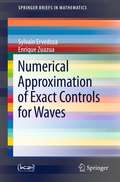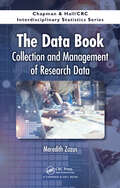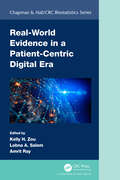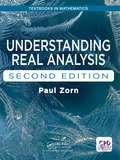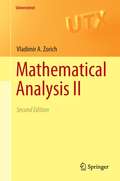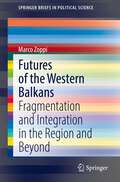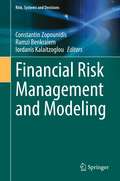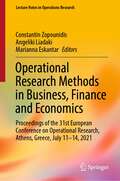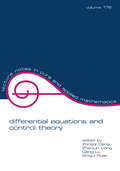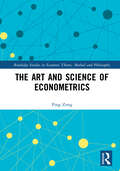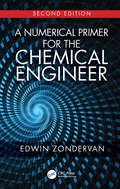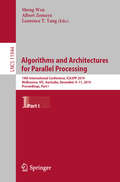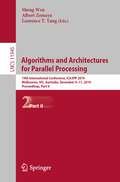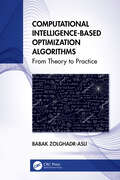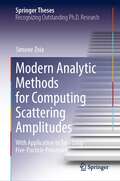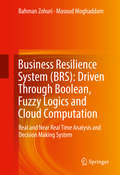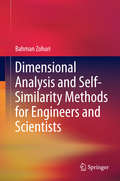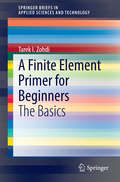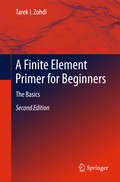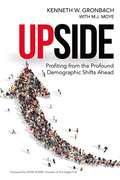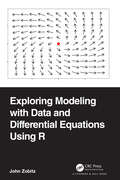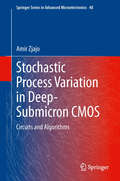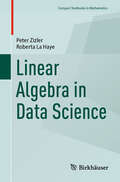- Table View
- List View
Numerical Approximation of Exact Controls for Waves
by Enrique Zuazua Sylvain ErvedozaThis book is devoted to fully developing and comparing the two main approaches to the numerical approximation of controls for wave propagation phenomena: the continuous and the discrete. This is accomplished in the abstract functional setting of conservative semigroups.The main results of the work unify, to a large extent, these two approaches, which yield similaralgorithms and convergence rates. The discrete approach, however, gives not only efficient numerical approximations of the continuous controls, but also ensures some partial controllability properties of the finite-dimensional approximated dynamics. Moreover, it has the advantage of leading to iterative approximation processes that converge without a limiting threshold in the number of iterations. Such a threshold, which is hard to compute and estimate in practice, is a drawback of the methods emanating from the continuous approach. To complement this theory, the book provides convergence results for the discrete wave equation when discretized using finite differences and proves the convergence of the discrete wave equation with non-homogeneous Dirichlet conditions. The first book to explore these topics in depth, "On the Numerical Approximations of Controls for Waves" has rich applications to data assimilation problems and will be of interest to researchers who deal with wave approximations.
The Data Book: Collection and Management of Research Data (Chapman & Hall/CRC Interdisciplinary Statistics)
by Meredith ZozusThe Data Book: Collection and Management of Research Data is the first practical book written for researchers and research team members covering how to collect and manage data for research. The book covers basic types of data and fundamentals of how data grow, move and change over time. Focusing on pre-publication data collection and handling, the text illustrates use of these key concepts to match data collection and management methods to a particular study, in essence, making good decisions about data. The first section of the book defines data, introduces fundamental types of data that bear on methodology to collect and manage them, and covers data management planning and research reproducibility. The second section covers basic principles of and options for data collection and processing emphasizing error resistance and traceability. The third section focuses on managing the data collection and processing stages of research such that quality is consistent and ultimately capable of supporting conclusions drawn from data. The final section of the book covers principles of data security, sharing, and archival. This book will help graduate students and researchers systematically identify and implement appropriate data collection and handling methods.
Real-World Evidence in a Patient-Centric Digital Era (Chapman & Hall/CRC Biostatistics Series)
by Kelly H Zou Lobna A. Salem Amrit RayReal-world evidence is defined as evidence generated from real-world data outside randomized controlled trials. As scientific discoveries and methodologies continue to advance, real-world data and their companion technologies offer powerful new tools for evidence generation. Real-World Evidence in a Patient-Centric Digital Era provides perspectives, examples, and insights on the innovative application of real-world evidence to meet patient needs and improve healthcare, with a focus on the pharmaceutical industry. This book presents an overview of key analytical issues and best practices. Special attention is paid to the development, methodologies, and other salient features of the statistical and data science techniques that are customarily used to generate real-world evidence. It provides a review of key topics and emerging trends in cutting-edge data science and health innovation. Features: Provides an overview of statistical and analytic methodologies in real-world evidence to generate insights on healthcare, with a special focus on the pharmaceutical industry Examines timely topics of high relevance to industry such as bioethical considerations, regulatory standards, and compliance requirements Highlights emerging and current trends, and provides guidelines for best practices Illustrates methods through examples and use-case studies to demonstrate impact Provides guidance on software choices and digital applications for successful analytics Real-World Evidence in a Patient-Centric Digital Era will be a vital reference for medical researchers, health technology innovators, data scientists, epidemiologists, population health analysts, health economists, outcomes researchers, policymakers, and analysts in the healthcare industry.
Understanding Real Analysis (Textbooks in Mathmatics)
by Paul ZornUnderstanding Real Analysis, Second Edition offers substantial coverage of foundational material and expands on the ideas of elementary calculus to develop a better understanding of crucial mathematical ideas. The text meets students at their current level and helps them develop a foundation in real analysis. The author brings definitions, proofs, examples and other mathematical tools together to show how they work to create unified theory. These helps students grasp the linguistic conventions of mathematics early in the text. The text allows the instructor to pace the course for students of different mathematical backgrounds.
Mathematical Analysis I
by Vladimir A. ZorichThis second English edition of a very popular two-volume work presents a thorough first course in analysis, leading from real numbers to such advanced topics as differential forms on manifolds; asymptotic methods; Fourier, Laplace, and Legendre transforms; elliptic functions; and distributions. Especially notable in this course are the clearly expressed orientation toward the natural sciences and the informal exploration of the essence and the roots of the basic concepts and theorems of calculus. Clarity of exposition is matched by a wealth of instructive exercises, problems, and fresh applications to areas seldom touched on in textbooks on real analysis. The main difference between the second and first English editions is the addition of a series of appendices to each volume. There are six of them in the first volume and five in the second. The subjects of these appendices are diverse. They are meant to be useful to both students (in mathematics and physics) and teachers, who may be motivated by different goals. Some of the appendices are surveys, both prospective and retrospective. The final survey establishes important conceptual connections between analysis and other parts of mathematics. The first volume constitutes a complete course in one-variable calculus along with the multivariable differential calculus elucidated in an up-to-date, clear manner, with a pleasant geometric and natural sciences flavor.
The Passionate Triangle
by Rebecca ZorachTriangles abounded in the intellectual culture of early modern Europe—the Christian Trinity was often mapped as a triangle, for instance, and perspective, a characteristic artistic technique, is based on a triangular theory of vision. Renaissance artists, for their part, often used shapes and lines to arrange figures into a triangle on the surface of a painting—a practice modern scholars call triangular composition. But is there secret meaning in the triangular arrangements artists used, or just a pleasing symmetry? What do triangles really tell us about the European Renaissance and its most beguiling works of art? In this book, Rebecca Zorach takes us on a lively hunt for the triangle’s embedded significance. From the leisure pursuits of Egyptian priests to Jacopo Tintoretto’s love triangles, Zorach explores how the visual and mathematical properties of triangles allowed them to express new ideas and to inspire surprisingly intense passions. Examining prints and paintings as well as literary, scientific, and philosophical texts, The Passionate Triangle opens up an array of new ideas, presenting unexpected stories of the irrational, passionate, melancholic, and often erotic potential of mathematical thinking before the Scientific Revolution.
Futures of the Western Balkans: Fragmentation and Integration in the Region and Beyond (SpringerBriefs in Political Science)
by Marco ZoppiThis Brief provides a survey of key political, social, and economic issues affecting the Western Balkans region. Taking a two-pronged conceptual approach focusing on fragmentation and integration, the volume highlights commonalities and differences in a number of simultaneous dynamics currently characterizing the region: Europeanization and EU access, market integration, and migration and socio-demographic transformations. Stressing the interconnectedness of these issues, the volume synthesizes key questions for the future of the region, such as the relationship between socio-demographic trends and economic development, the effects of depopulation on further EU integration, and the economic and political repercussions of enhanced intra-regional trade. Explicitly interdisciplinary, this Brief will be useful for researchers and students specializing in the Balkans and Western Balkans, post-socialist countries, European affairs, enlargement, foreign policy, international relations, regional studies, economics, economic transition, and socio-demographics.
Financial Risk Management and Modeling (Risk, Systems and Decisions)
by Constantin Zopounidis Ramzi Benkraiem Iordanis KalaitzoglouRisk is the main source of uncertainty for investors, debtholders, corporate managers and other stakeholders. For all these actors, it is vital to focus on identifying and managing risk before making decisions. The success of their businesses depends on the relevance of their decisions and consequently, on their ability to manage and deal with the different types of risk. Accordingly, the main objective of this book is to promote scientific research in the different areas of risk management, aiming at being transversal and dealing with different aspects of risk management related to corporate finance as well as market finance. Thus, this book should provide useful insights for academics as well as professionals to better understand and assess the different types of risk.
Operational Research Methods in Business, Finance and Economics: Proceedings of the 31st European Conference on Operational Research, Athens, Greece, July 11-14, 2021 (Lecture Notes in Operations Research)
by Constantin Zopounidis Liadaki Angeliki Eskantar MariannaThis book gathers selected high-quality papers presented at the 31st European Conference on Operational Research, which was held in Athens, Greece on June 11-14, 2021.It highlights the latest advances in the application of operations research (OR) to technology-driven areas in business, finance, and economics, covering both theoretical and methodological developments, as well as real-world case studies. It also explores the connections between OR and other analytical disciplines, such as soft computing and computer science, which can promote the development of new decision support technologies.
Differential Equations and Control Theory
by Zongqi Deng; Zhaojun Liang; Gang Lu; Shigui RuanThis work presents the proceedings from the International Conference on Differential Equations and Control Theory, held recently in Wuhan, China. It provides an overview of current developments in a range of topics including dynamical systems, optimal control theory, stochastic control, chaos, fractals, wavelets and ordinary, partial, functional and stochastic differential equations.
The Art and Science of Econometrics (Routledge Studies in Economic Theory, Method and Philosophy)
by Ping ZongToday econometrics has been widely applied in the empirical study of economics. As an empirical science, econometrics uses rigorous mathematical and statistical methods for economic problems. Understanding the methodologies of both econometrics and statistics is a crucial departure for econometrics. The primary focus of this book is to provide an understanding of statistical properties behind econometric methods. Following the introduction in Chapter 1, Chapter 2 provides the methodological review of both econometrics and statistics in different periods since the 1930s. Chapters 3 and 4 explain the underlying theoretical methodologies for estimated equations in the simple regression and multiple regression models and discuss the debates about p-values in particular. This part of the book offers the reader a richer understanding of the methods of statistics behind the methodology of econometrics. Chapters 5–9 of the book are focused on the discussion of regression models using time series data, traditional causal econometric models, and the latest statistical techniques. By concentrating on dynamic structural linear models like state-space models and the Bayesian approach, the book alludes to the fact that this methodological study is not only a science but also an art. This work serves as a handy reference book for anyone interested in econometrics, particularly in relevance to students and academic and business researchers in all quantitative analysis fields.
A Numerical Primer for the Chemical Engineer, Second Edition
by Edwin ZondervanDesigned as an introduction to numerical methods for students, this book combines mathematical correctness with numerical performance, and concentrates on numerical methods and problem solving. It applies actual numerical solution strategies to formulated process models to help identify and solve chemical engineering problems. Second edition comes with additional chapter on numerical integration and section on boundary value problems in the relevant chapter. Additional material on general modelling principles, mass/energy balances and separate section on DAE’s is also included. Case study section has been extended with additional examples.
Algorithms and Architectures for Parallel Processing: 19th International Conference, ICA3PP 2019, Melbourne, VIC, Australia, December 9–11, 2019, Proceedings, Part I (Lecture Notes in Computer Science #11944)
by Albert Zomaya Laurence T. Yang Sheng WenThe two-volume set LNCS 11944-11945 constitutes the proceedings of the 19th International Conference on Algorithms and Architectures for Parallel Processing, ICA3PP 2019, held in Melbourne, Australia, in December 2019. The 73 full and 29 short papers presented were carefully reviewed and selected from 251 submissions. The papers are organized in topical sections on: Parallel and Distributed Architectures, Software Systems and Programming Models, Distributed and Parallel and Network-based Computing, Big Data and its Applications, Distributed and Parallel Algorithms, Applications of Distributed and Parallel Computing, Service Dependability and Security, IoT and CPS Computing, Performance Modelling and Evaluation.
Algorithms and Architectures for Parallel Processing: 19th International Conference, ICA3PP 2019, Melbourne, VIC, Australia, December 9–11, 2019, Proceedings, Part II (Lecture Notes in Computer Science #11945)
by Albert Zomaya Laurence T. Yang Sheng WenThe two-volume set LNCS 11944-11945 constitutes the proceedings of the 19th International Conference on Algorithms and Architectures for Parallel Processing, ICA3PP 2019, held in Melbourne, Australia, in December 2019. The 73 full and 29 short papers presented were carefully reviewed and selected from 251 submissions. The papers are organized in topical sections on: Parallel and Distributed Architectures, Software Systems and Programming Models, Distributed and Parallel and Network-based Computing, Big Data and its Applications, Distributed and Parallel Algorithms, Applications of Distributed and Parallel Computing, Service Dependability and Security, IoT and CPS Computing, Performance Modelling and Evaluation.
Computational Intelligence-based Optimization Algorithms: From Theory to Practice
by Babak Zolghadr-AsliComputational intelligence-based optimization methods, also known as metaheuristic optimization algorithms, are a popular topic in mathematical programming. These methods have bridged the gap between various approaches and created a new school of thought to solve real-world optimization problems. In this book, we have selected some of the most effective and renowned algorithms in the literature. These algorithms are not only practical but also provide thought-provoking theoretical ideas to help readers understand how they solve optimization problems. Each chapter includes a brief review of the algorithm’s background and the fields it has been used in. Additionally, Python code is provided for all algorithms at the end of each chapter, making this book a valuable resource for beginner and intermediate programmers looking to understand these algorithms.
Modern Analytic Methods for Computing Scattering Amplitudes: With Application to Two-Loop Five-Particle Processes (Springer Theses)
by Simone ZoiaThis work presents some essential techniques that constitute the modern strategy for computing scattering amplitudes. It begins with an introductory chapter to fill the gap between a standard QFT course and the latest developments in the field. The author then tackles the main bottleneck: the computation of the loop Feynman integrals. The most efficient technique for their computation is the method of the differential equations. This is discussed in detail, with a particular focus on the mathematical aspects involved in the derivation of the differential equations and their solution. Ample space is devoted to the special functions arising from the differential equations, to their analytic properties, and to the mathematical techniques which allow us to handle them systematically. The thesis also addresses the application of these techniques to a cutting-edge problem of importance for the physics programme of the Large Hadron Collider: five-particle amplitudes at two-loop order. It presents the first analytic results for complete two-loop five-particle amplitudes, in supersymmetric theories and QCD. The techniques discussed here open the door to precision phenomenology for processes of phenomenological interest, such as three-photon, three-jet, and di-photon + jet production.
Business Resilience System (BRS) (BRS): Real and Near Real Time Analysis and Decision Making System
by Bahman Zohuri Masoud MoghaddamThis book provides a technical approach to a Business Resilience System with its Risk Atom and Processing Data Point based on fuzzy logic and cloud computation in real time. Its purpose and objectives define a clear set of expectations for Organizations and Enterprises so their network system and supply chain are totally resilient and protected against cyber-attacks, manmade threats, and natural disasters. These enterprises include financial, organizational, homeland security, and supply chain operations with multi-point manufacturing across the world. Market shares and marketing advantages are expected to result from the implementation of the system. The collected information and defined objectives form the basis to monitor and analyze the data through cloud computation, and will guarantee the success of their survivability's against any unexpected threats. This book will be useful for advanced undergraduate and graduate students in the field of computer engineering, engineers that work for manufacturing companies, business analysts in retail and e-Commerce, and those working in the defense industry, Information Security, and Information Technology.
Dimensional Analysis and Self-Similarity Methods for Engineers and Scientists
by Bahman ZohuriThis ground-breaking reference provides an overview of key concepts in dimensional analysis, and then pushes well beyond traditional applications in fluid mechanics to demonstrate how powerful this tool can be in solving complex problems across many diverse fields. Of particular interest is the book's coverage of dimensional analysis and self-similarity methods in nuclear and energy engineering. Numerous practical examples of dimensional problems are presented throughout, allowing readers to link the book's theoretical explanations and step-by-step mathematical solutions to practical implementations.
A Finite Element Primer for Beginners: The Basics (SpringerBriefs in Applied Sciences and Technology)
by Tarek I. ZohdiThe purpose of this primer is to provide the basics of the Finite Element Method, primarily illustrated through a classical model problem, linearized elasticity. The topics covered are: (1) Weighted residual methods and Galerkin approximations, (2) A model problem for one-dimensional linear elastostatics, (3) Weak formulations in one dimension, (4) Minimum principles in one dimension, (5) Error estimation in one dimension, (5) Construction of Finite Element basis functions in one dimension, (6) Gaussian Quadrature, (7) Iterative solvers and element by element data structures, (8) A model problem for three-dimensional linear elastostatics, (9) Weak formulations in three dimensions, (10) Basic rules for element construction in three-dimensions, (11) Assembly of the system and solution schemes, (12) Assembly of the system and solution schemes, (13) An introduction to time-dependent problems and (14) A brief introduction to rapid computation based on domain decomposition and basic parallel processing.
A Finite Element Primer for Beginners: The Basics (SpringerBriefs in Applied Sciences and Technology)
by Tarek I. ZohdiThe purpose of this primer is to provide the basics of the Finite Element Method, primarily illustrated through a classical model problem, linearized elasticity. The topics covered are: (1) Weighted residual methods and Galerkin approximations, (2) A model problem for one-dimensional linear elastostatics, (3) Weak formulations in one dimension, (4) Minimum principles in one dimension, (5) Error estimation in one dimension, (5) Construction of Finite Element basis functions in one dimension, (6) Gaussian Quadrature, (7) Iterative solvers and element by element data structures, (8) A model problem for three-dimensional linear elastostatics, (9) Weak formulations in three dimensions, (10) Basic rules for element construction in three-dimensions, (11) Assembly of the system and solution schemes, (12) Assembly of the system and solution schemes, (13) An introduction to time-dependent problems and (14) A brief introduction to rapid computation based on domain decomposition and basic parallel processing.
Upside: Profiting from the Profound Demographic Shifts Ahead
by John Zogby Kenneth W. Gronbach M. J. MoyeDemographics not only define who we are, where we live, and how our numbers change, but—for those who can read beyond the raw figures—they open up hidden business opportunities that lie ahead.What will happen when retiring Boomers free up jobs? How will Generation Y alter housing and transportation? Which states will have the most dynamic workforces? Will American manufacturing rebound as Asia’s population boom stalls?Upside puts this powerful yet little-understood science to work finding answers. Demographer Kenneth Gronbach synthesizes reams of data to show how generations impact markets and economies, and how to target promising trends. Lively and full of surprises, the book explains:What each age cohort is likely to buy now and in coming decades How profits dovetail with consumer numbers What sectors are likely to grow or lag How to make sense of the numbers to chart your own path And moreAs waves of people are born and age, fortunes and futures are determined. Whether you’re an investor, marketer executive, or entrepreneur, Upside helps you spot the potential for profits in ever-shifting demographics.
Exploring Modeling with Data and Differential Equations Using R
by John ZobitzExploring Modeling with Data and Differential Equations Using R provides a unique introduction to differential equations with applications to the biological and other natural sciences. Additionally, model parameterization and simulation of stochastic differential equations are explored, providing additional tools for model analysis and evaluation. This unified framework sits "at the intersection" of different mathematical subject areas, data science, statistics, and the natural sciences. The text throughout emphasizes data science workflows using the R statistical software program and the tidyverse constellation of packages. Only knowledge of calculus is needed; the text’s integrated framework is a stepping stone for further advanced study in mathematics or as a comprehensive introduction to modeling for quantitative natural scientists. The text will introduce you to: modeling with systems of differential equations and developing analytical, computational, and visual solution techniques. the R programming language, the tidyverse syntax, and developing data science workflows. qualitative techniques to analyze a system of differential equations. data assimilation techniques (simple linear regression, likelihood or cost functions, and Markov Chain, Monte Carlo Parameter Estimation) to parameterize models from data. simulating and evaluating outputs for stochastic differential equation models. An associated R package provides a framework for computation and visualization of results. It can be found here: https://cran.r-project.org/web/packages/demodelr/index.html.
Stochastic Process Variation in Deep-Submicron CMOS
by Amir ZjajoOne of the most notable features of nanometer scale CMOS technology is the increasing magnitude of variability of the key device parameters affecting performance of integrated circuits. The growth of variability can be attributed to multiple factors, including the difficulty of manufacturing control, the emergence of new systematic variation-generating mechanisms, and most importantly, the increase in atomic-scale randomness, where device operation must be described as a stochastic process. In addition to wide-sense stationary stochastic device variability and temperature variation, existence of non-stationary stochastic electrical noise associated with fundamental processes in integrated-circuit devices represents an elementary limit on the performance of electronic circuits. In an attempt to address these issues, Stochastic Process Variation in Deep-Submicron CMOS: Circuits and Algorithms offers unique combination of mathematical treatment of random process variation, electrical noise and temperature and necessary circuit realizations for on-chip monitoring and performance calibration. The associated problems are addressed at various abstraction levels, i. e. circuit level, architecture level and system level. It therefore provides a broad view on the various solutions that have to be used and their possible combination in very effective complementary techniques for both analog/mixed-signal and digital circuits. The feasibility of the described algorithms and built-in circuitry has been verified by measurements from the silicon prototypes fabricated in standard 90 nm and 65 nm CMOS technology.
Linear Algebra in Data Science (Compact Textbooks in Mathematics)
by Peter Zizler Roberta La HayeThis textbook explores applications of linear algebra in data science at an introductory level, showing readers how the two are deeply connected. The authors accomplish this by offering exercises that escalate in complexity, many of which incorporate MATLAB. Practice projects appear as well for students to better understand the real-world applications of the material covered in a standard linear algebra course. Some topics covered include singular value decomposition, convolution, frequency filtering, and neural networks. Linear Algebra in Data Science is suitable as a supplement to a standard linear algebra course.
Multiple View Geometry in Computer Vision
by Andrew Zisserman Richard HartleyA basic problem in computer vision is to understand the structure of a real world scene given several images of it. Techniques for solving this problem are taken from projective geometry and photogrammetry. Here, the authors cover the geometric principles and their algebraic representation in terms of camera projection matrices, the fundamental matrix and the trifocal tensor. The theory and methods of computation of these entities are discussed with real examples, as is their use in the reconstruction of scenes from multiple images. The new edition features an extended introduction covering the key ideas in the book (which itself has been updated with additional examples and appendices) and significant new results which have appeared since the first edition. Comprehensive background material is provided, so readers familiar with linear algebra and basic numerical methods can understand the projective geometry and estimation algorithms presented, and implement the algorithms directly from the book.
